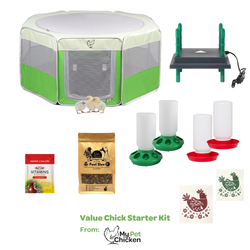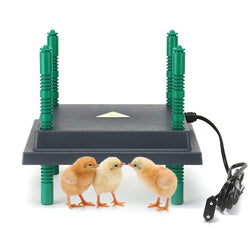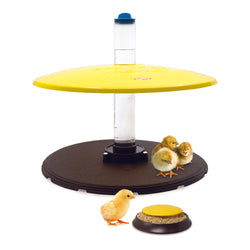Four Important Feather Foot Concerns
Back to blog
Feather foot chickens: there's just something about the magnificent feathered legs of breeds like cochins or silkies. Fancy feathered chickens in general---including those with crests, beards, tufts and/or muffs---can be fun to keep as pets, simply because they're so showy and spectacular. Many people have never seen feather footed chickens before. Sometimes even the chickens themselves seem surprised.
But before you consider keeping feather foot chickens, there are a few issues to consider. Just as you'd want to know about any special issues with a prospective pet dog or cat breed (Long hair that needs frequent grooming? Pushed-in snout? Heavy shedder? Hard to house train?), you want to be aware of the issues associated with feather foot chickens before you acquire any, so you can be prepared.
4 main concerns when keeping feather foot chickens:
1. Leg mites Chickens with feathered legs are generally more vulnerable to scaly leg mites than chickens without the feather foot quality. The feathers emerge from beneath the leg scutes (scales), and make it easy for the mites to infest! While scaly leg mites are usually fairly easy to treat for at home, the feathered legs can make it more difficult, and significantly messier, to do so.
2.Picking Fancy feathering in general can be a problem when it comes to picking. Picking basically means your bird can get picked on--actually, that's literally what it means when it comes to chickens. If you keep 5 "regular" chickens---that is, having no fancy feathering---and one poor soul with a crest or feathered legs, for example, the other birds may try to pluck out her "weird" feathering. Picking is not usually caused by keeping birds with fancy feathering, but fancy feathering can exacerbate the problem sometimes. Particularly in the case of hens and even roosters who are also submissive, having the feather foot characteristic can lead to bloody legs and serious problems. There are ways you can deal with picking issues... but picking can get to be a habit, so it's best to avoid having it happen in the first place. Take common sense precautions like providing plenty of space and entertainment, lots of room on roosts and at feeders, and make sure you don't just have one poor fancy-feathered bird as the odd hen out.
3. Muddy eggs Those leg feathers look beautiful in breed pictures and illustrations. However, in the real world they don't usually remain so perfectly coifed (or would that be plumed?). Unless you live in a dry or desert area, make sure you site your coop and run so that it doesn't get muddy. It's not just a matter of being unsightly on their feathers, and not just a matter of (ick) possibly having their legs covered with muddy droppings. If your hens have muddy, poopy leg feathers, they will carry that mud into the nests, and your eggs will be a mess, too. Do you want to wash them all? (Usually, the answer is no--and not just because it's a lot of extra work, but because washing them can lead to problems!) If you want your hens to hatch the eggs, having them covered with dirty poopiness can make them vulnerable to bacterial infection.
4. Frostbite You'd think the feathered legs would provide more warmth in a cold season, rather than be a cause for concern! Especially with bantam feathered leg breeds---since bantams can have more difficulty with cold---you'd think that leg feathers would help. And that's partly true. They do offer some extra protective insulation. However the problem again is with wet weather. If your chickens have a wet or snowy run and get slush or mud embedded in their legs feathers, that can freeze hard and cause frostbite issues.
These issues are certainly not deal-breakers when it comes to feather foot chickens. It just requires a little extra vigilance to make sure leg mites don't become a problem, and an effort to provide your flock with a dry area---one that's large enough to avoid stressing the flock with overcrowding that could lead to picking. What are your favorite feather foot chicken breeds?



